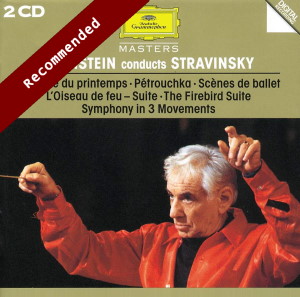
Igor Stravinsky (1882-1971)
Le sacre du printemps (1913)
Pétrouchka (1911, rev. 1947)
L’Oiseau de feu (1910, rev. 1919)
Symphony in Three Movements (1945)
Scènes de ballet (1944)
Israel Philharmonic Orchestra/Leonard Bernstein
rec. 1982/84, Frederic Mann Auditorium, Tel Aviv, Israel
Presto CD
DEUTSCHE GRAMMOPHON 445 538-2 [72 + 64]
This double CD set collects the three great ballets Stravinsky wrote for Diaghilev in the 1910s, plus bonuses of two works from three decades later in his “neoclassical” period.
As preparation for this review, I first listened to two of Bernstein’s famous, earlier recordings of the Rite of Spring, from 1958 with the New York Philharmonic and from 1972 with the London Symphony Orchestra. The former has a sharp, spiky brilliance and a raw, punchy energy which are very striking while the latter enjoys a bigger, rounder recording acoustic and greater sonority from an LSO in top form – both are very seductive and afford much pleasure – but the main advantage of this live 1982 recording is the depth and clarity of the digital sound which delivers a bass resonance missing in the previous two recordings. (There is also a live recording from Tanglewood in 1987 with the Boston Symphony Orchestra which I have not heard.) This later account from Tel Aviv might not be quite as energised as the previous two but there is certainly no lack of drive in Bernstein’s direction and the massive quality of the sound greatly enhances the impact and violence of the percussive sections. Nor is there any appreciable difference in accomplishment and virtuosity amongst the three orchestras he directed; his exuberance clearly inspired them all.
Subtler effects, too, such as the soft, high, haunting discord before silence, then the pounding percussion and blaring brass of the “Adoration de la terre” are wonderfully atmospheric; Bernstein is never one to sell dramatic pauses short and daringly extends them, such as that after the “Danse de la Terre” before the Introduction to the Second Part. Some lovely playing from a whole battery of solo instruments – trombone, the trumpet, horn and flute graces the eerie Largo and “Cercle mystérieux des adolescents” sections before the thunderous explosion of the “Glorification de l’Élue”. All Stravinsky’s daring, even outrageous effects – the blaring, tonguing trumpets and snarling brass, the zany syncopations – come off splendidly; if there are any of the mistakes perhaps inevitable in a live performance, my amateur ears do not hear them. The finale is crowned by the final, resounding thwack following the piccolo’s upward run, putting the seal on a deeply satisfying, magnificently wild and powerful account.
Bernstein always relished the dramatic possibilities of Petrushka and treated it as a theatrical, narrative experience rather than a classical suite. He brings out the warm colours and contrasts, the syncopations, the sheer vivacity and the vivid, pictorial qualities of the music, all abetted by some first-rate orchestral playing – especially the percussion section – the solo pianist Bernard Berman and sparkling sound engineering. This is – at first, at least, until Petrushka is slain – joyful, exuberant music and no conductor was better suited than Bernstein to infuse it with the required elan – and he is equally adept in bringing out the humorous, mawkish and poignant qualities attached to the depiction of the puppet himself, the exotic menace of the Moor, the ponderous bear and the many other attendant vignettes combining to produce the liveliest impression possible of the Shrovetide Fair.
The contrast in ambience between Petrushka and The Firebird is marked but Bernstein moves effortlessly from conjuring up the rumbustious galumphing of the fair to the eerie, delicate traceries of the magic garden and the orchestral sound is correspondingly lighter; even in the “Infernal Dance”, the momentum is fleeter, textures are alternately lusher and more transparent and the control of the strings’ pianissimo tremolo at the end of the “Lullaby” is especially impressive.
The ‘Scènes de ballet’ illustrate how Stravinsky’s conception of dance music for the stage evolved over thirty years – although far from being Russian folkloric ballet this was composed in the spirit of Broadway dance. Nonetheless, some typically Stravinskian tropes are apparent. Its odd combination of classical lyricism, spiky modernism and ironic sentimentality does not much appeal to me but I can hear that Bernstein gives it ideal advocacy. The ‘Symphony in Three Movements’ I find more interesting and cohesive; it, too, displays the discernible trademarks typical of the composer – in particular, his characteristic deployment of syncopation, percussion and solo piano – and I hear echoes of a lot of Bernstein’s own music in it – or rather, the other way round: his music echoes Stravinsky’s.
Nicholas Kenyon’s notes are full, useful and informative. Live recordings these may be, but they are indistinguishable from studio productions as there is no problem with any imbalances or extraneous noise; there isn’t a peep out of the Israeli audiences in the Frederic Mann Auditorium. If you want a flawlessly played, beautifully presented collection of these ballets, this Presto re-issue should be your go-to destination.
Ralph Moore
Published: December 1, 2022
Help us financially by purchasing through



















